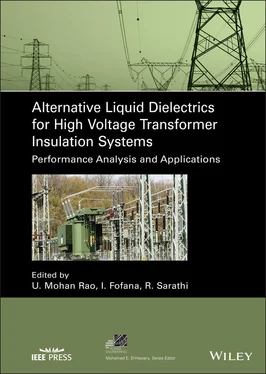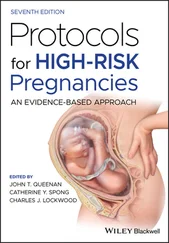1 Cover
2 Series Page IEEE Press 445 Hoes Lane Piscataway, NJ 08854 IEEE Press Editorial Board Ekram Hossain, Editor in Chief Jón Atli Benediktsson Xiaoou Li Jeffrey Reed Anjan Bose Lian Yong Diomidis Spinellis David Alan Grier Andreas Molisch Sarah Spurgeon Elya B. Joffe Saeid Nahavandi Ahmet Murat Tekalp
3 Title Page
4 Copyright Page
5 Dedication Page
6 Editor Biographies
7 List of Contributors
8 Acknowledgments
9 Editorial
10 1 Liquid Insulation for Power Transformers 1.1 Background of Liquid‐Filled Transformers 1.2 Insulation System in Liquid‐Filled Transformers 1.3 Insulation Aging Phenomena in Transformers 1.4 Transformer Insulating Liquids References
11 2 Processing and Evaluation of Natural Esters 2.1 Introduction 2.2 Significant Natural Ester Liquids 2.3 Processing and Pretreatment 2.4 Properties and Evaluation of Natural Esters 2.5 Degradation of Different Vegetable Oils 2.6 Dissolved Gas Analysis in Natural Esters 2.7 Challenges in Using Natural Esters as Insulating Liquid 2.8 Conclusions and Future Scope References
12 3 Compatibility of Esters with Cellulosic Insulation Materials 3.1 Introduction 3.2 Procedure of Accelerated Thermal Aging 3.3 Assessment of Liquid Degradation 3.4 Assessment of Paper Degradation 3.5 Remaining Life of Transformer Insulation 3.6 Conclusions References
13 4 Degradation Assessment of Ester Liquids 4.1 Introduction 4.2 Procedure of Accelerated Thermal Aging 4.3 Assessment of Liquid Degradation 4.4 Assessment of Paper Degradation 4.5 Conclusions and Future Scope References
14 5 End Life Behavior of Ester Liquids in High‐Voltage Transformers 5.1 Introduction 5.2 Evolution of Colloidal and Soluble Decay Particles 5.3 Colloidal Particles – Centrifugal Treatment (ASTM D1698) 5.4 Soluble Particles – Fuller's Earth Filtration (ASTM D7150) 5.5 Feasibility of Fuller's Earth Filtration for Ester Liquids 5.6 Conclusions and Future Scope References
15 6 Prebreakdown and Breakdown Phenomena in Ester Dielectric Liquids 6.1 Introduction 6.2 Research Methods in Assessment of Prebreakdown Phenomena in Ester Liquids 6.3 Initiation of Streamers in Dielectric Liquids 6.4 Streamer Propagation 6.5 Influence of Temperature on Prebreakdown Phenomena in Natural Ester Liquids 6.6 Influence of Thermal Aging on Prebreakdown Phenomena in Synthetic Ester Liquids 6.7 Conclusions and Future Scope References
16 7 Miscibility and Engineering Application of a Novel Mixed Fluid 7.1 Introduction 7.2 Need and Research Progress of Mixed Insulating Liquids 7.3 Preparation Method for the New Mixed Insulating Oil 7.4 Thermal Aging Characteristics of the New Mixed Insulation Oil–Paper Insulation and Its Delaying Thermal Aging Mechanism 7.5 Mechanism of Property Enhancement of the New Mixed Insulation Oil on Power Frequency Breakdown of Oil–Paper Insulation 7.6 Enhancing Effect and Mechanism of the New Mixed Insulation Oil on Flashover Voltage of Oil–Paper Insulation 7.7 Application of the New Mixed Insulation Oil: Service Experiences 7.8 Conclusions and Future Scope References
17 8 Natural Ester Nanosfluids as Alternate Insulating Oils for Transformers 8.1 Introduction 8.2 Preparation of Natural Ester Nanofluids and Stability Analysis 8.3 Properties of Natural Esters and Natural Ester Nanofluids 8.4 Conclusion References
18 9 Dielectric Properties of Silica‐Based Synthetic Ester Nanofluid 9.1 Introduction 9.2 Nanofluid Preparation and Characterization 9.3 Frequency Domain Dielectric Response 9.4 Time Domain Dielectric Response 9.5 Conduction at High Electric Field 9.6 Corona Inception Voltage 9.7 Conclusions and Future Scope References
19 10 Behavior of Ester Liquids Under Various Operating Fault Conditions 10.1 Introduction 10.2 Dissolved Gas Analysis and Transformer Faults 10.3 Simulation of Various Faults in Laboratory Environment 10.4 Influence of Different Faults on the State of Liquid and Gassing Tendency 10.5 Conclusions and Future Scope References
20 11 In‐Service Performance of Natural Esters 11.1 Introduction 11.2 Reasons Why These Utilities Chose a Natural Ester 11.3 Transformers Under Study 11.4 Summary of Research Applied to Manage These Transformers 11.5 Fluid Temperature at Rated Load 11.6 Breakdown Voltage and Water Content 11.7 Investigations into Oxidation and Handling Fluid‐Impregnated Paper 11.8 Study on Installation and Early Operation of a Power Transformer Filled with Natural Ester 11.9 Fleet Measurements 11.10 Summary References
21 Index
22 Books in the IEEE Press Series on Power Engineering
23 End User License Agreement
1 Chapter 2 Table 2.1 Typical fatty acid composition of some vegetable oils. Table 2.2 Basic properties of NEO [2,6–8, 13, 21, 26]. Table 2.3 Composition of Pongamia. Table 2.4 Composition of Jatropha. Table 2.5 IEC gas ratios. Table 2.6 Types of faults. Table 2.7 Doernenburg gas ratio method. Table 2.8 Types of faults by Doernenburg ratio method. Table 2.9 Types of faults by Rogers ratio method. Table 2.10 Types of faults.
2 Chapter 3 Table 3.1 Proportions of materials for thermal aging according to IEC 62332‐... Table 3.2 Aging temperatures found in the bibliography. Table 3.3 Initial moisture content of solid insulation. Table 3.4 Material ratio in the aging process.Table 3.5 Constants to determine per unit transformer insulation life.Table 3.6 Loss of life data according to [108] and [113].Table 3.7 Estimated parameters of Eq. (3.24).Table 3.8 Estimated parameters of Eq. (3.25).Table 3.9 Estimated parameters of Eq. (3.30), applying different end‐of‐life...Table 3.10 Correlation of DP and retained tensile strength (%).
3 Chapter 4Table 4.1 Fatty acid composition of vegetable oils.Table 4.2 Breakdown voltage of ester fluids under AC and DC voltages.Table 4.3 Flash point and fire point of ester fluids.Table 4.4 Dynamic viscosity of ester fluids.Table 4.5 Dielectric permittivity and dissipation factor of ester fluids [17...Table 4.6 Recommended aging temperature and duration of insulating fluids.Table 4.7 PDIV of thermally aged ester fluids under AC harmonic frequencies.Table 4.8 PDIV of thermally aged ester fluids under AC harmonic frequencies ...Table 4.9 Evaluation of different methods used for ECT of fluids.Table 4.10 Limits on IFT based on voltage class of transformer.Table 4.11 Composition of thermal aged ester fluid (160 °C) based on GC‐MS d...Table 4.12 Surface discharge inception voltage (SDIV) of thermally aged este...Table 4.13 Surface discharge inception voltage (SDIV) of thermally aged este...Table 4.14 Equivalent electrical circuit parameters.
4 Chapter 6Table 6.1 Propagation velocities for different streamer modes.Table 6.2 Sequence of phenomena that occur in the point‐to‐plane electrode s...
5 Chapter 7Table 7.1 Characteristics of base oil samples.Table 7.2 Main parameters of the three base oils.Table 7.3 Viscosity and tanδ of mixed oil with different proportions of palm...Table 7.4 Results of further adjustment on the proportion.Table 7.5 IOT of mixed oil with different antioxidants.Table 7.6 IOT of mixed oil with different antioxidants.Table 7.7 Parameters of the novel three‐element mixed insulation oil.Table 7.8 Parameters of cellulose polymers.Table 7.9 Parameters of the three‐element mixed insulation oil and 25# miner...Table 7.10 Sample grouping and oil treatment.Table 7.11 Test method and standard of parameter measurement.Table 7.12 Fitting results of DP values with kinetic equation.Table 7.13 Expected life of cellulose paper in thermal aging test (130 °C).Table 7.14 Calculated and measured DP values after 90 days.Table 7.15 Addition mass ratio of H 2O and H 3O +in two insulation oils (%).Table 7.16 Simulation parameters.Table 7.17 Hydrogen bonds and interaction energy in three‐element mixed insu...Table 7.18 Hydrogen bonds and interaction energy in mineral oil–paper system...Table 7.19 Dielectric loss of the new three‐element mixed insulation oil‐imp...Table 7.20 Relative permittivity of insulation materials.Table 7.21 Electric fields (kV/mm) at the middle of the oil gap and the oil‐...Table 7.22 The equivalent flashover voltages at 5% probability and average v...Table 7.23 The equivalent flashover voltages at 5% probability and average v...Table 7.24 The equivalent breakdown voltages at 5% probability and average v...Table 7.25 Magnitude of electric field intensity (
Читать дальше












